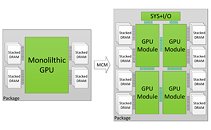- Joined
- Oct 9, 2007
- Messages
- 47,690 (7.42/day)
- Location
- Dublin, Ireland
| System Name | RBMK-1000 |
|---|---|
| Processor | AMD Ryzen 7 5700G |
| Motherboard | Gigabyte B550 AORUS Elite V2 |
| Cooling | DeepCool Gammax L240 V2 |
| Memory | 2x 16GB DDR4-3200 |
| Video Card(s) | Galax RTX 4070 Ti EX |
| Storage | Samsung 990 1TB |
| Display(s) | BenQ 1440p 60 Hz 27-inch |
| Case | Corsair Carbide 100R |
| Audio Device(s) | ASUS SupremeFX S1220A |
| Power Supply | Cooler Master MWE Gold 650W |
| Mouse | ASUS ROG Strix Impact |
| Keyboard | Gamdias Hermes E2 |
| Software | Windows 11 Pro |
AMD is reportedly accelerating launch of its first GPU architecture built on the 7 nanometer process, codenamed "Navi." Graphics cards based on the first implementation of "Navi" could launch as early as by Q3-2018 (between July and September). Besides IPC increments with its core number-crunching machinery, "Navi" will introduce a slew of memory and GPU virtualization technologies.
AMD will take its multi-chip module (MCM) approach of building high-performance GPUs a step further, by placing multiple GPU dies with their HBM stacks on a single package. The company could leverage its InfinityFabric as a high-bandwidth interconnect between the GPU dies (dubbed "GPU module"), with an I/O controller die interfacing the MCM with the host machine. With multi-GPU on the decline for games, it remains to be seen how those multiple GPU modules are visible to the operating system. In the run up to "Navi," AMD could give its current "Vega" architecture a refresh on a refined 14 nm+ process, to increase clock speeds.

View at TechPowerUp Main Site
AMD will take its multi-chip module (MCM) approach of building high-performance GPUs a step further, by placing multiple GPU dies with their HBM stacks on a single package. The company could leverage its InfinityFabric as a high-bandwidth interconnect between the GPU dies (dubbed "GPU module"), with an I/O controller die interfacing the MCM with the host machine. With multi-GPU on the decline for games, it remains to be seen how those multiple GPU modules are visible to the operating system. In the run up to "Navi," AMD could give its current "Vega" architecture a refresh on a refined 14 nm+ process, to increase clock speeds.

View at TechPowerUp Main Site












